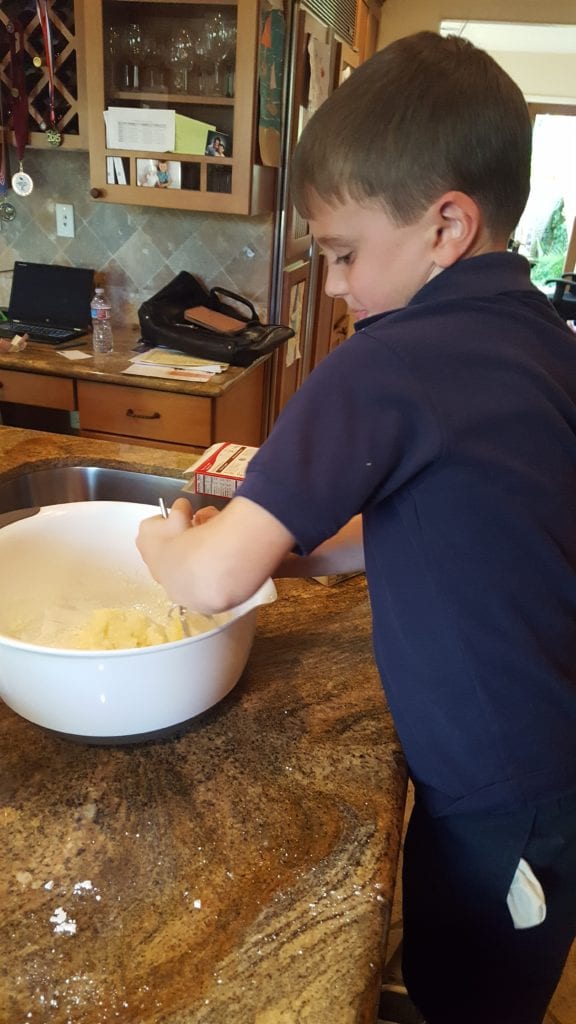“August is Kids Eat Right™ month. Kids Eat Right™ month focuses on the importance of healthful eating and active lifestyles for children and families. It’s a time to highlight the role that everyone plays in ensuring a healthy future for our nation’s children.”
As a Registered Dietitian I help teach parents and children how to eat healthy and learn the important role that nutrition plays in their growth. However, that’s not to say preparing food for children can’t be a challenge. Understatement of the year, am I right parents? Here are a few common complaints that I hear often:
“How can I get my kid to eat more vegetables? He/She hates them ALL!”
“Should I give my child a vitamin? This way I can make sure he/she’s getting the nutrients he/she should be getting?”
“My child is SO picky!” “Dinner time leads to a fight/battle between myself and my husband to get my child to eat the food that’s been prepared. Dinner time is stressful!”
If you think you’re the only one having these kinds of problems, think again. These are just a few of the complaints that I get from parents. Having spent a few days with my nephews recently, I can attest to the dislike of not only veggies but also seafood. My one nephew is more willing to try new foods and experiment at the age of 12. Whereas my nephew that’s almost 9 has a deep hatred for all things green and any kind of seafood. So much so he can gag/vomit almost just from the sight of them. So I write these suggestions from an outsider looking in, having made many observations of what not to do. This may be helpful seeing as many of you are in the thick of it just as my brother is. So here they are, a few suggestions to help you get your kids to eat a little better, & not just those infamous vegetables:

Parents and caregivers supply the three “Ws” of meals and snacks: What foods are offered, When and Where they’re eaten. The child fills in the other “W” and “H”: Which offered foods to eat and How much. This is a discussion that needs to take place so that the children understand the parent’s role and the children understand their role.
Make a schedule. Children need to eat every three to four hours: three meals, two snacks, and lots of fluids. If you plan for these, your child’s diet will be much more balanced and they’ll be less cranky, because they won’t be famished. The key is to make sure to plan ahead and bring food with you if you’re out and about. And by the way, this works for adults too!
Plan dinners. If thinking about a weekly menu is too daunting, start with two or three days at a time. A good dinner doesn’t have to be fancy, but it should be balanced: whole-grain bread, rice, or pasta; a fruit or vegetable; and a protein source like lean meat, cheese, or beans. The key is planning and not trying to decide at 5:00 what’s for dinner.
Don’t become a short-order cook. This is a bad habit to start and then an even harder one to stop – cooking a separate meal for the adults and a meal for the kids, just because you know they’ll eat it. I know you want your kids to eat, but this can become exhausting. The key is to make sure that there is at least one thing on the plate that you know the kids will eat. Never try to introduce two new foods at once. That’s what I call an epic fail. Sure you’re excited to try that new recipe out, but if there isn’t something familiar on the plate the kids will not eat it. Make one meal for everybody. Children will mimic their parents’ behavior, so make sure you and your spouse are both on the same page.
This really is a tough one. Believe me. Again I just saw this in real life happening. We’re all eating crawfish etouffee and Joshua is eating chicken nuggets. It’s an easy trap to fall in. You want the child to eat something. There was rice he was able to eat and carrots (as a veggie offered). And while there was no protein, that would be okay in this situation instead of having to prepare him special “chicken nuggets”. The key is letting them know this is what’s for dinner, they may not like it, and that’s okay, but then letting them know there will be a snack offered later if he is still hungry. And at that snack time you can offer some protein – some cheese and crackers, 1/2 peanut butter sandwich, etc. Definitely easier said than done. And definitely where you would want to be on the same page as your spouse.
Bite your tongue. As hard as this may be, try not to comment on what or how much your kids are eating. Be as neutral as possible. Your job as a parent is to provide food that is balanced; your kids are responsible for eating them. If you play food enforcer – saying things like “Eat your vegetables” – your child will only resist. No one wants a fight at the table.
Once again, easy to say, hard not to do. If you could only will your child to eat those veggies. Ha ha, yes, if it only worked that way. I think the key is setting the expectations at mealtime before sitting down. So then you’re not repeating or coaxing the children to “eat their veggies”. Remember it’s their job to eat the food that’s offered. And if they choose night after night to not eat their veggies, that’s their choice (again remembering to instill a one bite rule is a nice way to not fight at the table. I’m not here to waste food, but the key is offering variety of veggies and variety of ways veggies are being prepared – there will be a way they might like the veggie. Believe me.)
Introduce new foods slowly. Children are new-food-phobic by nature. They actually tend to like eating the same thing over and over (and no they don’t get bored easily. This is otherwise known as a food jag). Taste buds have to get used to a flavor before the kids actually begin to like the taste. A little hero worship can work wonders too. Next time your kid refuses to eat spinach tell them that Captain America eats his to stay big and strong. Your kid might just want to eat his spinach the next time! And of course remember to try introducing a new food in many different forms. Kids like to have different tastes and textures and may not like a food simply based on the way it was prepared. Keep this in mind when you think that you’ve tried them every way possible. Here are a few spinach recipes that are quite tasty and offering spinach in three different forms:
Spinach Pancakes – Believe it or not, the spinach doesn’t affect the taste. It simply provides the green color. No tricking the children, let them see you put spinach in the batter and blend it all up. Then let them pleasantly be surprised that they can’t taste it. Green pancakes for the win!
Spinach Strawberry Salad – I would take lots of the spinach leaves and roll them up together and cut them (chiffonade them up!), so the kids aren’t looking at actual spinach leaves, but the spinach in a different form, more like lettuce. With kids appearance is everything and worst case scenario they eat all the strawberries and pecans.
Spinach Artichoke Dip – while this does include two foods children may not like – spinach and artichokes – the winning part of this recipe is all the cheese. Kids love cheese!! And it’s a dip – who doesn’t like a good dip? Which leads to my next tip:
Dip it. If your kids won’t eat vegetables, experiment with dips. My nephews love to dip their food. I found a yogurt-based ranch dressing that isn’t full of fat and won’t bother my brother if all they do is lick the dressing off and won’t eat the carrot (of course that’s the ultimate goal, but there are times when all they do is lick the dressing off and don’t eat the carrots. It’s what kids do!) You can also try hummus, salsa, or even experiment and make up your own!
Make mornings count. Most families don’t eat enough fiber on a daily basis, and breakfast is an easy place to sneak it in, whether it’s with oatmeal or whole grain toast. Or, do what I do and make-up batches of whole-grain pancakes that can last all week (I am a kid at heart). For a batch that serves 6 (2 pancakes a piece), sift together ¾ cup all-purpose flour, ¾ cup whole wheat flour, 1 Tbsp. sugar, 1 ½ tsp. baking powder, ½ tsp. baking soda, ½ tsp. salt. Next mix 1 ½ cups buttermilk, 1 Tbsp. vegetable oil, 1 large egg, and 1 large egg white. Combine the liquid ingredients with the dry ingredients and there you’ve got your homemade pancake batter! If you want to make up extra, they freeze well too!
Get Kids Cooking. If your kids become involved in choosing or preparing meals, they’ll be more interested in eating what they’ve created. Take them to the store, and let them choose the produce for you. If they’re old enough, allow them to cut up vegetables and mix them into a salad. Kids take ownership in things that they’ve made. The odds are higher that they’ll try it if they’re involved in the process.

Cut back on junk. Remember, you – not your kids – are in charge of the foods that enter the house. By having fewer junk foods around, you’ll force your children to eat more fruits, vegetables, whole grains, and dairy products. What’s available is what they’ll go for, so make your house stocked full of healthy options.
Parents always ask me about desserts (and this leads in to the next tip as well) but I think that’s a personal choice on the frequency of how often desserts are allowed in to the mix. What I would say is this – go back to my previous point of not begging children to eat their veggies or using a phrase like, “If you eat your veggies then you can have dessert.” It’s not helpful in the long-run. Short-term they’ll probably eat their veggie at that particular meal, but then they know if they eat their veggies then in theory they’ll be getting dessert. It doesn’t work that way and dessert shouldn’t be a daily thing.
Allow treats. Having less healthy foods occasionally keeps them from becoming forbidden – and thus even more appealing. The problem with treats is that kids are so used to having these daily that they expect a treat daily. A treat is supposed to be exactly that, something to look forward to, not an everyday item. Candy, soda, and cookies can be “sometimes” foods. Eating out at a fast food restaurant of their choice every so often can be allowed. It’s truly about balance and moderation.
Have fun. The more creative the meal, the greater variety of foods kids will eat. You can make smiley-face pancakes and you can give foods silly names (broccoli florets can be “baby trees”). Anything mini is always a hit with kids as well. You can use cookie cutters to turn toast into hearts and stars, all things kids will love.
Be a role model. If you’re constantly on a diet or have erratic eating habits, your kids will grow up thinking that this sort of behavior is normal. Be honest with yourself about the kinds of food messages that you’re sending. Trust your body to tell you when you’re hungry and when you’re full, and your kids will learn to do the same. I must mention this here as well, if one parent is not eating vegetables, the odds are your kids will not want to eat them either – Monkey see, monkey do. Again, be a good role model. If vegetables are not your thing either, find a new one to try all together. I challenge kids when they say they don’t like vegetables. There’s no way they’ve tried them all and they just need to focus on the ones that they do like versus thinking that they like none. And I get it, it can be exhausting at times trying to be creative with the veggies. This is where involving the kids can make a difference. Now that my one nephew is 12, I challenge him to look up a recipe that he might want to try. And I explain that we might win some and we might lose some – they can’t all turn out to be “keepers”.
Adjust your attitude. Realize that what your kids eat over time is what matters. Some parents get upset at the dinner table when their kids aren’t eating the foods that they’ve prepared. Don’t get caught up on focusing on just one meal. Look at the whole day of everything that they’ve had to eat. And even more broad, look at the whole week versus focusing on just one day. Kids will eat when they’re hungry. The key is offering the meals at set times as well as snacks. This way even if they don’t eat that much at dinner (because it just wasn’t their favorite) a snack before bedtime is important to help provide extra nutrients the kids need (and again if they’re hungry, they’ll eat!)
Kids Eat Right™ month is designated as August every year, however, every month and every day paves the way for kids to eat right. Teaching children healthy eating habits that ensure that they’re getting the nutrients that they need starts at a young age. Getting kids to eat healthfully doesn’t have to be complicated. Variety, Balance, and Moderation along with a lot of patience will help kids eat right and you’re on your way!






